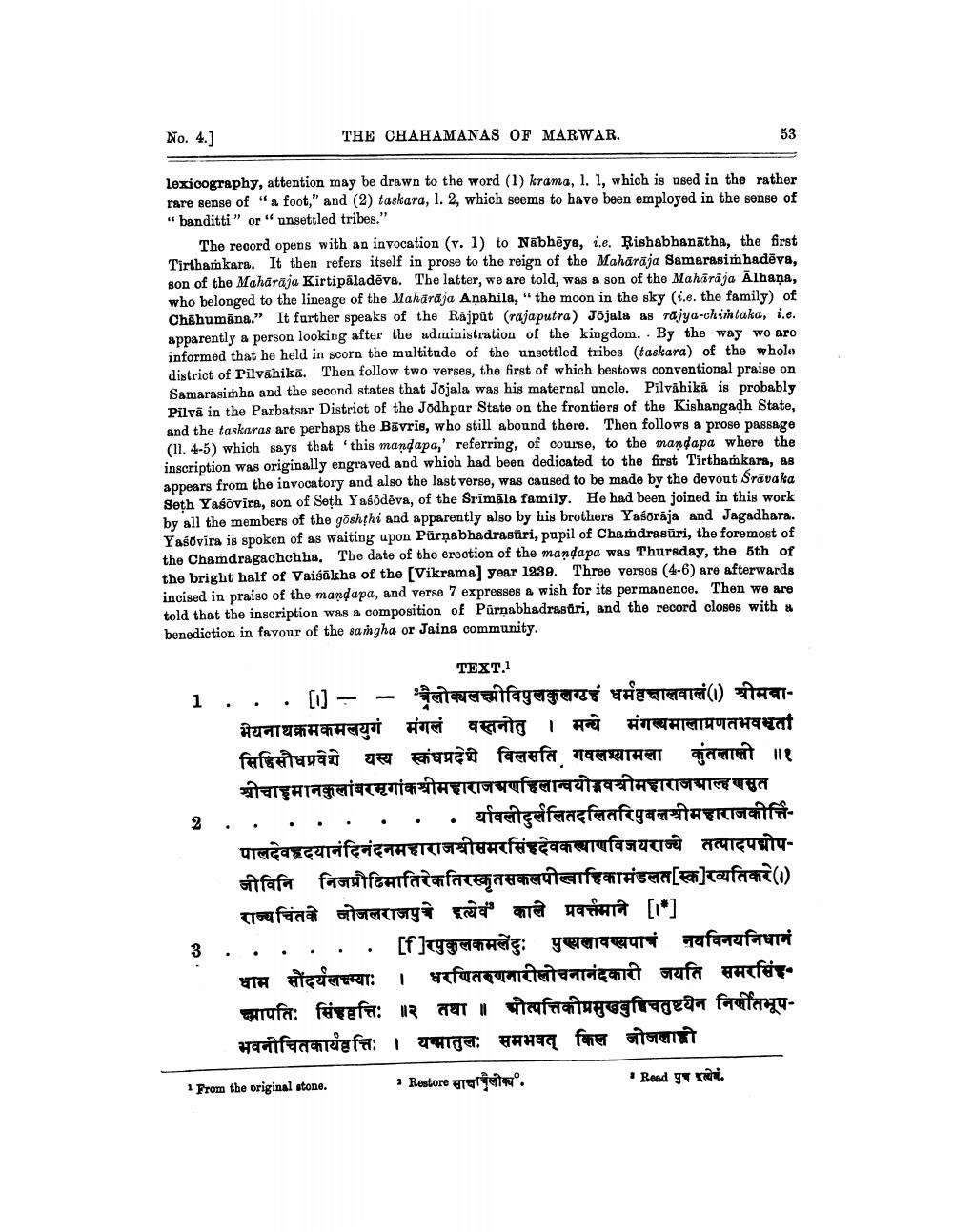________________
No. 4.]
THE CHAHAMANAS OF MARWAR.
lexicography, attention may be drawn to the word (1) krama, 1. 1, which is used in the rather rare sense of "a foot," and (2) taskara, 1.2, which seems to have been employed in the sense of “ banditti" or " unsettled tribes."
The record opens with an invocation (v. 1) to Nabheya, ie. Rishabhanatha, the first Tirtham kara. It then refers itself in prose to the reign of the Maharaja Samarasimhadēva, son of the Mahārāja Kirtipäladēve. The latter, we are told, was a son of the Mahārāja Ālhana, who belonged to the lineage of the Maharaja Anahila, “ the moon in the sky (i.e. the family) of Chāhumāna." It further speaks of the Rajput (rajaputra) Jõjala as rajya-chintaka, i.e. apparently a person looking after the administration of the kingdom. . By the way we are informed that he held in scorn the multitude of the unsettled tribes (taskara) of the wholo district of Pilvahika. Then follow two verses, the first of which bestows conventional praise on Samarasimha and the second states that Jojala was his maternal uncle. Pilvähika is probably Pilvā in the Parbatsar District of the Jodhpar State on the frontiers of the Kishangadh State, and the taskaras are perhaps the Bāvris, who still abound there. Then follows a prose passage (11. 4-5) which says that this mandapa,' referring, of course, to the mandapa where the inscription was originally engraved and whioh had been dedicated to the first Tirtham kars, as appears from the invocatory and also the last verse, was caused to be made by the devout Srävaka Seth Yaśovira, son of Seth Yasodēva, of the Srimāla family. He had been joined in this work by all the members of the goshthi and apparently also by his brothers Yasoraja and Jagadhara. Yasovira is spoken of as waiting upon Purnabhadrastri, pupil of Chamdrasuri, the foremost of the Chamdragachchha. The date of the erection of the manda pa was Thursday, the 5th of the bright half of Vaisakha of the [Vikrama] year 1988. Three verses (4-6) are afterwards incised in praise of the mandapa, and verse 7 expresses & wish for its permanence. Then we are told that the inscription was a composition of Purnabhadrasuri, and the record closes with benediction in favour of the samgha or Jaina community.
TEXT.1 1 . . . [1] - - "त्रैलोक्यलक्ष्मीविपुलकुलग्यहं धर्मवृक्षालवाल(1) श्रीमबा
भयनाथक्रमकमलयुगं मंगलं वस्तनोतु । मन्ये मंगल्यमालाप्रणतभवभूता सिदिसौधप्रवेशे यस्य स्कंधप्रदेश विलसति गवलण्यामला कुंतलाली १ श्रीचाहुमानकुलांबरमृगांकश्रीमहाराजभणहिलान्वयोगवश्रीमहाराजथाल्हणसुत . . . . . . . . र्यावलीदुर्ललितदलितरिपुबलश्रीमहाराजकीर्तिपालदेवदयानंदिनंदनमहाराजश्रीसमरसिंहदेवकल्याणविजयराज्ये तत्पादपद्मोपजीविनि निजप्रौढिमातिरेकतिरस्कृतसकलपीवाहिकामंडलत[स्क]रव्यतिकरे(।)
राज्यचिंतके जोजलराजपुत्र इत्येवं काले प्रवर्त्तमान [*] 3 . . . . . . [f]रपुकुलकमलेंदु: पुस्थलावण्यपात्रं नयविनयनिधानं
धाम सौंदर्यलक्ष्म्याः । धरणितरुणनारीलोचनानंदकारी जयति समरसिंह मापतिः सिंहवृत्तिः ॥२ तथा ॥ पौत्पत्तिकीप्रमुखबुधिचतुष्टयन निर्शीतभूपभवनीचितकार्यत्ति: । यमातुल: समभवत् किल जोजलाही
1 From the original stone.
, Restore साचालोक्य
- Read पुष रत्येवं.




